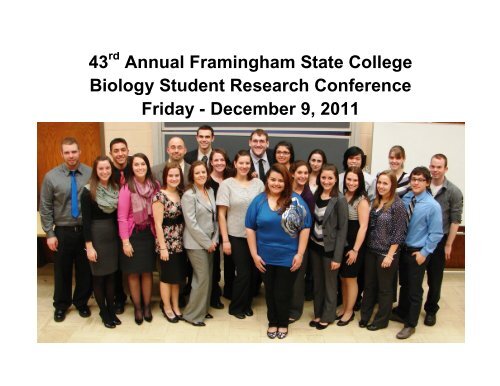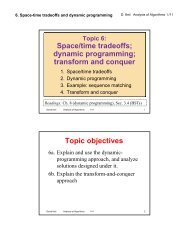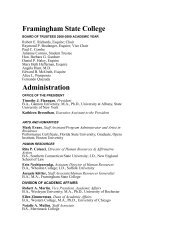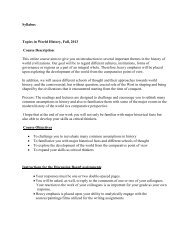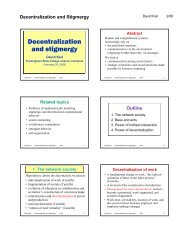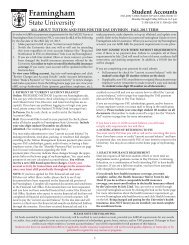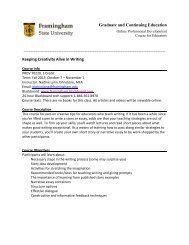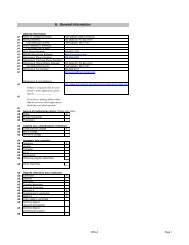Abstracts 2011 - Framingham State University
Abstracts 2011 - Framingham State University
Abstracts 2011 - Framingham State University
Create successful ePaper yourself
Turn your PDF publications into a flip-book with our unique Google optimized e-Paper software.
43 rd Annual <strong>Framingham</strong> <strong>State</strong> College<br />
Biology Student Research Conference<br />
Friday - December 9, <strong>2011</strong>
The Thornton Award is given each year<br />
in memory of Shaun Thornton, a biology<br />
major who died in a motorcycle accident<br />
in 1993, several days after receiving the<br />
award for the best presentation at the<br />
24 th Annual <strong>Framingham</strong> <strong>State</strong> College<br />
Biology Student Research Conference.<br />
The award is given to the presenter(s) of<br />
the best oral and/or poster of their<br />
research.<br />
The Thornton Award Winners:<br />
1993 Jason Fitzpatrick<br />
1994 Diane Caunt<br />
1995 Amy Donoghue<br />
and Terry O’Connell<br />
1996 Gianna Troiano<br />
1997 Jim Uthoff (oral)<br />
James Griffin (poster)<br />
1998 Julie Ploof<br />
1999 Scott Andrea<br />
2000 Mark Cooperman (oral)<br />
Deidre Osborne (poster)<br />
2001 Virginia Rainville<br />
2002 Azra Ahmed<br />
2003 Scott Alconada<br />
2004 Anita Lovely<br />
2005 Heather Paquin<br />
2006 Jeane Webster<br />
2007 Jennifer Bertolasio<br />
2008 Carol Furnari<br />
2009 Andrew Grassetti<br />
2010 Edwin Castillo
<strong>Framingham</strong> <strong>State</strong> <strong>University</strong><br />
43 rd Biology Student Research<br />
Conference<br />
Hemenway Hall - Room HH-G36<br />
December 9, <strong>2011</strong><br />
12:30 Welcome<br />
12:45<br />
Efficacy of a polysaccharide vaccine to protect against Staphylococcus<br />
pseudintermedius in a mouse model of canine hotspots. Chris Walla<br />
1:00<br />
Biochemical effects of alternative preservation techniques on diced tomatoes.<br />
Nicholas De Souza - Thornton Memorial Award, Honorable Mention<br />
1:15<br />
Nestmate recognition in the mating context for Polistes dominulus paper wasps.<br />
Jessica Wells<br />
1:30<br />
Efficacy of Heat-Killed Bacterin Vaccine against Staphylococcus<br />
pseudintermedius in a mouse model of Canine Pyoderma. Marice Tang<br />
1:45<br />
Parasitism of imported Green Tree Pythons (Morelia viridis) and Scrub Pythons<br />
(Morelia amethistina). Krysten Dufort<br />
2:00<br />
Variation in Ossification Sequence of Cranial Bones in Hyla chrysoscelis.<br />
Brian Dagley<br />
2:15<br />
The Effect of Stanozolol on Spatial Learning and Reproductive Structures in Male<br />
Rats. Eli Wolff<br />
2:30<br />
The effects of salinity on the metamorphosis of Botrylloides violaceus larvae.<br />
Joanne Connolly<br />
Efficacy of a Heat-Killed Cell Vaccine to Provide Protection Against<br />
2:45 Staphylococcus pseudintermedius Pyoderma in a Mouse Model of Canine<br />
Hotspots. Ashley Covel
3:00 Ethinylestradiol Effects on Xenopus laevis Metamorphosis. Kathleen Barry<br />
3:15<br />
Resveratrol’s influence on cell proliferation and apoptosis following DNA damage.<br />
Samantha Goodwin<br />
3:30 Break<br />
3:45<br />
Changes in Diel Patterns of Birdsong in Response to Increased Urban Noise.<br />
Cayla Allar<br />
4:00<br />
Larval Substrate Preference by the Invasive Tunicate Botrylloides violaceus.<br />
Jaqueline Taravella<br />
4:15<br />
Determination of Resveratrol’s Effects on Expression of Sirtuin Responsive<br />
Genes. Katerina Tylicki - Thornton Memorial Award<br />
4:30<br />
Development and Malformations of the Vertebral Column of Hyla chrysoscelis.<br />
Jennifer Melgar<br />
Heating and Cooling Rates of the Red – Eared Slider (Trachemys scripta<br />
4:45 elegans) in Response to Controlled Changes in Ambient Temperature.<br />
Ryan Tibbert<br />
5:00 Heating and cooling rate of Morelia amethistina. Billion Ao<br />
5:15<br />
Possible secondary functions of wing-spreading in Double-crested cormorants<br />
(Phalacrocorax auritus). Kristen DeMoranville<br />
5:30<br />
Facial pattern as an indicator of body size and emergence date in Polistes<br />
dominulus paper wasps. Meray Rasla<br />
5:45<br />
Biochemical Properties of Diced Tomatoes after Microwave Processing and<br />
Storage. Paul Tieri<br />
6:00<br />
Effect of Resveratrol on Expression of Estrogen Responsive Proto-Oncogenes.<br />
Sarah Ferguson<br />
Temperature for Tun Formation in Hypsibius sp. Tardigrades.<br />
6:15 Peter B. Tobin - Thornton Memorial Award, Honorable Mention<br />
6:30 Photo Session … Meanwhile, Judges Convene<br />
7:30 Biology Research Conference Banquet<br />
La Cantina Restaurant - <strong>Framingham</strong><br />
Presentation of The Thornton Award
Welcome to the 43 rd Annual <strong>Framingham</strong> <strong>State</strong> College Biology Student Research<br />
Conference. Each year our students present the results of their independent<br />
research at this conference. These presentations represent the culmination of a year<br />
of hard work. Through this first-hand research experience, our students come to<br />
understand the scientific process and appreciate the complexity and diversity of<br />
biological systems.
Chris Wallace<br />
Efficacy of a polysaccharide<br />
vaccine to protect against<br />
Staphylococcus pseudintermedius<br />
in a mouse model of canine<br />
hotspots.<br />
Canine pyoderma, or “hot spots”, is a skin infection in dogs caused by the commensal<br />
bacterium Staphylococcus pseudintermedius and is characterized by alopecia,<br />
erythema, pustules and inflammation. Immunological tolerance is a state of<br />
unresponsiveness of the immune system; tolerance is perhaps the mechanism that<br />
allows a commensal to become a pathogen. This study used BALB/c mice as a model<br />
for canine pyoderma; the mice were injected intraperitoneally with a purified<br />
polysaccharide vaccine prepared from the bacterium. This study examined two<br />
different protocols, with the hypothesis that Protocol A would provide protection while<br />
Protocol B would induce immunological tolerance. In protocol A, mice were given 2<br />
vaccinations, 3 weeks apart; in protocol B, mice were given 3 vaccinations, 6 weeks<br />
apart. A control group was injected with phosphate buffered saline under the same<br />
protocols to measure the effect of the innate immune system of the mouse. The mice<br />
were then challenged with live S. pseudintermedius KL175; pyodermal lesions were<br />
recovered 5 days later, serially diluted and plated to determine the number of viable<br />
bacteria. Bacteria recovered for the vaccinated mice were compared against mice in a<br />
control group that were injected with phosphate-buffered saline (PBS) following the<br />
same protocol. A Wilcoxon-Mann-Whitney test was used to compare efficacy of the<br />
vaccine compared to the PBS control. Mice administered the polysaccharide vaccine<br />
following Protocol A had a greater number of bacteria killed when compared to mice of<br />
the PBS control. The results were not significant (2-Tailed, P=0.0522). Mice<br />
administered the polysaccharide vaccine follow Protocol B showed equal number of<br />
bacteria killed when compared to mice of the PBS control group (2-Tailed, P=0.7697).<br />
Efficacy of polysaccharide vaccine using protocol A was not definitive, but does<br />
warrant future research.<br />
Methods<br />
Vaccination<br />
32.5 μg per dose (1.6 mg/kg)<br />
2 Vaccinations with a 3 week interval<br />
3 Vaccinations with a 6 week interval<br />
Methods<br />
Serial dilutioned<br />
1:10<br />
Colony Counts
Nicholas De Souza<br />
Biochemical effects of alternative<br />
preservation techniques on diced<br />
tomatoes.<br />
The current benchmark preservation technique, canning, can drastically alter<br />
nutritional and sensory characteristics due to overprocessing. Thus, there is an<br />
increased interest in alternative preservation techniques, two of which are highpressure<br />
processing and ohmic heating. Both preservation techniques seek to<br />
produce a product that is as safe as a thermally processed product by inactivating<br />
enzymes and harmful microorganisms associated with food spoilage, while maintaining<br />
superior sensory and nutritional value. High-pressure processing utilizes highpressure,<br />
typically between 400 – 600 MPa, while ohmic heating utilizes electrical<br />
currents to rapidly and uniformly heat food. To determine the biochemical effects of<br />
these processing techniques, this study used peroxidase activity as a measure of<br />
enzyme inactivation, and total phenolics as a measure of nutritional value. Peroxidase<br />
was examined because it is one of the most thermally stable plant enzymes, and it<br />
catalyzes many reactions associated with food spoilage. Phenolic compounds were<br />
examined because they act as antioxidants and can help protect cells from damage<br />
caused by free radicals. Diced tomato samples processed by Ohio <strong>State</strong> <strong>University</strong><br />
were examined to assess biochemical changes. Both high-pressure processing and<br />
ohmic heating inactivated peroxidase as effectively as canned control groups,<br />
immediately after processing. Both preservation techniques also preserved total<br />
phenolics as effectively as canned control groups, throughout a storage period. These<br />
results suggest that both alternative processing techniques perform as well as<br />
conventional thermal processing on a biochemical level. Further research is required<br />
to determine if either technique is superior. This research was part of an ongoing<br />
multi-institutional USDA study aimed at evaluating several different processing<br />
techniques.<br />
Ohmic Heating<br />
Utilizes electrical currents<br />
Inactivates enzymes/microorganisms<br />
Potentially superior food quality post-processing<br />
http://ohioline.osu.edu/fse-fact/0004.html<br />
Concentration of total phenolics<br />
(mg/g tissue)<br />
25.0<br />
20.0<br />
15.0<br />
10.0<br />
5.0<br />
0.0<br />
I & II<br />
Total Phenolics Analysis<br />
High-Pressure Processing<br />
I<br />
I/II<br />
III<br />
I<br />
I<br />
I/III<br />
HPP CaCl2<br />
HPP CaLaGlu<br />
Contadina<br />
Del Monte<br />
Del Monte (no salt)<br />
One-way ANOVA: p < 0.01
Jessica Wells<br />
Nestmate recognition in the mating<br />
context for Polistes dominulus<br />
paper wasps.<br />
Breeding with relatives tends to lower the fitness of offspring because there is a higher<br />
chance of receiving two harmful alleles. In Hymenoptera (the ants, bees, and wasps)<br />
females are diploid and males are usually haploid. If the sex-determining locus is<br />
heterozygous a female is produced, and if it is homo- or hemizygous, a male is<br />
produced. When inbreeding occurs, there is a 50% chance that the offspring receive<br />
two of the same allele at their sex-determining locus, producing a diploid male. Diploid<br />
males can be sterile, and lower the entire colony’s fitness, because the males do not<br />
do any work. Polistes dominulus paper wasps are a successful invasive species in the<br />
United <strong>State</strong>s and diploid males have only been found in their introduced range. It is<br />
well known that P. dominulus uses cuticular hydrocarbons for kin recognition, but it is<br />
unknown whether they use this recognition to avoid mating with relatives. I observed<br />
behavioral trials of a focal male, one female nestmate, and one female non-nestmate<br />
to test whether he had mate preference. I also observed one focal female, one male<br />
nestmate, and one male non-nestmate to test whether the female showed aggression<br />
towards the male nestmate, if he tried to mate with her. The males did not choose the<br />
non-nestmate significantly more than the nestmate and there was no mating related<br />
aggression between males and females. Both the focal male and focal female did<br />
however on average antennate more with non-nestmates. These results suggest that<br />
P. dominulus does recognize the difference between a nestmate and a non-nestmate,<br />
but does not discriminate when choosing a mate. If a female cannot find an optimal<br />
mate and inbreeding does occur, on average she will produce 50% female workers,<br />
and therefore have potential for a successful colonization despite the diploid male<br />
production.<br />
• Six nests<br />
collected<br />
• Attachment of<br />
nest in insect<br />
carrier<br />
• Marking<br />
Collection of Nests<br />
Non-aggressive Interactions Higher<br />
Towards Non-nestmates<br />
Mean antennations<br />
2<br />
1.8<br />
1.6<br />
1.4<br />
1.2<br />
1<br />
0.8<br />
0.6<br />
0.4<br />
0.2<br />
0<br />
Wilcoxon Signed-Rank Test<br />
P = 0.02<br />
Nestmate Non-nestmate
Marice Tang<br />
Efficacy of Heat-Killed Bacterin<br />
Vaccine against Staphylococcus<br />
pseudintermedius in a mouse<br />
model of Canine Pyoderma.<br />
Canine pyoderma is the skin disease in dogs caused by Staphylococcus<br />
pseudintermedius. In most cases it is recurrent after treatment with antibiotics, causing<br />
an economic burden to the dog owner and increasing the probability of antibiotic<br />
resistance. Consequently, the development of a vaccine against S. pseudintermedius<br />
is priority. A previous study (Curtis et al 2006) reported that an autogenous bacterin<br />
vacccine in combination with antibiotics was successful, controlling the disease. In our<br />
laboratory, in a mouse model, LaCroix in 2007(unpublished) demonstrated the efficacy<br />
of a polysaccharide vaccine against canine pyoderma and Herrera in 2010<br />
(unpublished) reported that tolerance appeared to be induced by extending LaCroix's<br />
immunization schedule. This study used the mouse model to investigate the influence<br />
of timing of vaccination in either immune protection or tolerance. It was predicted that<br />
mice immunized twice with a three-weeks interval would develop protection and by<br />
extending to three doses with a six-week interval mice would became immune tolerant<br />
to S. pseuintermedius. The vaccine was prepared from heat-killed whole cells and<br />
extracellular proteins of S. pseudintermedius, strain KL-175. Forty Balb/c mice were<br />
immunized, Bacterin group (~ 2x10 6 bacteria/50μL) and Control group (50μL of sterile<br />
saline), challenged with live KL-175 (~ 2x10 6 cfu/50μL) ten days after the last<br />
immunization dose, then sacrificed five days after being challenged. Tissue from the<br />
site of infection was collected, homogenized and serially diluted for bacterial analysis.<br />
Colony forming units were counted and percent killing was calculated to determine<br />
vaccine efficacy. Mice from the efficacy group did not develop protection (Bacterin =<br />
17% kill and PBS = 60% kill, P= 0.207011, df=3) and mice from the tolerance group did<br />
not develop immune tolerance (Bacterin = 33% kill and PBS = -106% kill, P=<br />
0.871527,df=10). These results were contrary to the expected results and are not<br />
significant according to t-test.<br />
Protection Group<br />
1 3 weeks 2<br />
Tolerance Group<br />
Overall Schedule Overview<br />
10 days<br />
Challenge<br />
1 6 weeks 2 6 weeks 3<br />
5 days<br />
10 days<br />
Sacrifice<br />
Challenge<br />
5 days<br />
Questions ?<br />
news.xinhuanet.com/english2007-11/11/content_7051229_2.htm
Krysten Dufort<br />
Parasitism of imported Green Tree<br />
Pythons (Morelia viridis) and Scrub<br />
Pythons (Morelia amethistina).<br />
Millions of wild-caught reptiles are traded in the exotic pet trade every year. The<br />
majority of these reptiles come from Indonesia and Malaysia, and among these reptiles<br />
the most commonly traded snake genera are Cobras (Naja) and Pythons (Python).<br />
Many of these reptiles are parasitized, as they come from tropical areas with high<br />
parasite abundance. In the wild, reptiles often demonstrate a balanced host-parasite<br />
relationship, where the parasite thrives with little to no effects on the hosts’ fitness and<br />
health. However, when reptiles are brought into captivity, the extra stress suppresses<br />
the reptile’s immune system, making them more susceptible to the negative effects of<br />
parasitism. The purpose of this study was to gain an understanding of the parasites<br />
found in wild-caught Green Tree Pythons (Morelia viridis) and Scrub Pythons (Morelia<br />
amethistina) imported from Indonesia. Twenty snakes were dissected and their organs<br />
were examined for parasites. Fifty percent of the snakes examined were parasitized<br />
with a mean parasite load of 7.4 parasites per snake. A total of 74 parasites were<br />
found, all of which were nematodes found in the digestive tract of the snakes. There<br />
was no significant difference (p=0.09) in the mean number of parasites found in male<br />
and female Green Tree Pythons, however the female parasite load was 7 times higher<br />
than the males. Positive allometry was observed between snout-vent-length (SVL)<br />
and number of parasites (mass exponent = 1.8). Females were significantly longer<br />
than males (p=0.007), possibly explaining the higher parasite loads in female Green<br />
Tree Pythons. The older the host, the greater the intensity of infection, and because<br />
snakes exhibit indeterminate growth, larger snakes were expected to have higher<br />
parasite loads. Overall, this study provided a better understanding of the types of<br />
parasites found in Green Tree Pythons as well as the locations where they are<br />
commonly found.<br />
Green Tree Python Scrub Python<br />
http://commons.wikimedia.org/wiki/File:Green_Tree_Python.jpg<br />
# of parasites<br />
100<br />
10<br />
# of parasites in Green Tree Pythons<br />
increases with snout-vent-length<br />
y = 0.0016x 1.7857<br />
R² = 0.1881<br />
Female<br />
Male<br />
Juvenile<br />
1<br />
10 100 1000<br />
(Allometry: note log scale)<br />
SVL (cm)
Brian Dagley<br />
Variation in Ossification Sequence<br />
of Cranial Bones in Hyla<br />
chrysoscelis.<br />
The osteology of Hyla chrysoscelis, a North American Hylidae tree frog, has never<br />
been described. Intraspecific variation in ossification sequence and timing of cranial<br />
bones was measured in a large sample of pre-metamorphic and metamorphosing<br />
tadpoles of this species, and the pattern of cranial ossification was described.<br />
Specimens were cleared, double-stained, and staged, and snout-vent length was used<br />
to index body size. Number of cranial elements exhibiting ossification was recorded for<br />
each individual. All specimens followed the same sequence of onset of ossification in<br />
elements. Ossification initiated in general correspondence to the functional groups of<br />
bones comprising (1) the braincase and otic capsules, (2) the upper and lower jaws,<br />
and (3) the suspensorium. Snout-vent length did not correspond to number of<br />
elements exhibiting ossification in individuals within Gosner stages, and was not a<br />
good estimate of specimen age. Future studies could determine whether total percent<br />
ossification in individuals within stages correlates with body size, and comparison in<br />
ossification sequence and timing of Hyla chrysoscelis could be made with related hylid<br />
species such as Acris blanchardi, Pseudacris crucifier, and Hypsiboas lanciformis.<br />
These hylid species have diverse life histories, and an interspecific comparison could<br />
determine if such differences in life histories are correlated with differences in<br />
ossification sequence and timing.<br />
Jaws - Premaxillae<br />
500 μm 500 μm<br />
Stage 42 Stage 44<br />
Average Number of Bones Exhibiting Ossification<br />
Avg number of bones exhibiting ossification<br />
12<br />
10<br />
Avg. Number of Bones Exhibiting<br />
Ossification vs. Stage<br />
8<br />
6<br />
4<br />
2<br />
0<br />
29 31 33 35 37 39 41 43 45<br />
Gosner Stage
Eli Wolff<br />
The Effect of Stanozolol on Spatial<br />
Learning and Reproductive<br />
Structures in Male Rats.<br />
Stanozolol is an androgenic anabolic steroid (AAS) used sparingly in western medicine<br />
to combat osteoporosis, anemia, and AIDS-related wasting. It is also used illegally in<br />
athletics to improve performance. Anabolic steroids are known to have varied and<br />
pronounced impact on the nervous system manifested by changes in behavior and<br />
mental function. Androgenic compounds also have an important role in the function<br />
and maintenance of reproductive tissue, such as the testes, prostate, and seminal<br />
vesicles. While AAS drugs are typically used to harness their anabolic effects on<br />
muscle, bone, and erythropoiesis, they can often cause side effects to the reproductive<br />
and nervous systems. Twenty-eight adult male rats were treated with Stanozolol in<br />
canola oil vehicle for 14 consecutive days. A Morris Water Maze was then utilized to<br />
assess treatment effects on spatial learning. After the behavioral test, animals were<br />
sacrificed and reproductive organs were removed and weighed. Stanozolol showed no<br />
effect on learning. No significant changes were seen in the bodyweight of the animals<br />
as a result of the treatments. Animals treated with stanozolol had significantly lower<br />
testes weights but there was no effect on weight of either seminal vesicles or prostate.<br />
These data show that stanozolol treatment can affect the reproductive tract, however,<br />
further testing is required before a conclusion can be made regarding affects on the<br />
nervous system.<br />
Seminal<br />
Vesicles<br />
ORGANS<br />
Prostate<br />
(under<br />
bladder)<br />
Exposed<br />
Testicle<br />
Testes Weight (grams)<br />
4<br />
3.5<br />
3<br />
2.5<br />
2<br />
1.5<br />
1<br />
0.5<br />
0<br />
TESTES WEIGHT<br />
A B<br />
B<br />
High Dose Low Dose Oil Stan/Flu<br />
Treatment<br />
A
Joanne Connolly<br />
The effects of salinity on the<br />
metamorphosis of Botrylloides<br />
violaceus larvae.<br />
Botrylloides violaceus is an invasive marine tunicate that can be found on natural and<br />
artificial substrates. It can be harmful to the environment because it is known to<br />
overgrow and smother mussels, which are important commodities for fishermen. I<br />
surveyed the population of these tunicates in four areas in and around Gloucester, MA.<br />
I then exposed the larvae to different salinities in order to find their optimal salinity and<br />
minimum tolerated salinity to find out which environments they can inhabit, to see if<br />
they would continue to spread to and invade other habitats. I found that B. violaceus<br />
larvae have an optimal salinity between 20 and 30 ppt, and they die at salinities of 15<br />
ppt and under. My research indicates that B. violceaus cannot live in the low salinities<br />
of an estuary but may continue to reproduce in the higher salinities of the intertidal<br />
zone. Suggested future research would be to assess the growth rate of the larvae in a<br />
range of salinities to see if their optimal salinity for growth is also from 20 to 30 ppt, and<br />
if they have a lower minimum tolerated salinity in the adult stage.<br />
Larval release<br />
Light shock (Bullard and Whitlatch 2004)<br />
Results-Lab Experiment<br />
Average Metamorphosed<br />
120<br />
100<br />
80<br />
60<br />
40<br />
20<br />
0<br />
-20<br />
Average Amount of Larvae Metamorphosed<br />
per Salinity<br />
C<br />
C<br />
B<br />
A, B<br />
15 17 18 20 22 25 27 30<br />
Salinity (ppt)<br />
Tukey’s test: F 7, 15=36.157, P
Ashley Covel<br />
Efficacy of a Heat-Killed Cell<br />
Vaccine to Provide Protection<br />
Against Staphylococcus<br />
pseudintermedius Pyoderma in a<br />
Mouse Model of Canine Hotspots.<br />
Canine pyoderma, a superficial skin infection observed in dogs caused by the primary<br />
pathogen Staphylococcus pseuduintermedius, is commonly characterized by pustules<br />
that form on the skin. Current treatment for pyoderma consists of antibiotic regimens,<br />
which are costly and not always effective. Frequent usage of antibiotics has selected<br />
for resistant strains of bacteria. Recurrent infections can occur and are not prevented<br />
by antibiotics alone; therefore a vaccine that can protect against the bacterium is<br />
necessary. Vaccine treatments have been studied; however autogenous bacterins,<br />
which are made from individual infections, have only been used. A potential vaccine is<br />
a heat-killed whole cell injection made from S. pseudintermedius strain KL-175. The<br />
goal was to determine the efficacy of the vaccine, and whether extending the<br />
vaccination schedule would provide increased protection or induce tolerance in a<br />
mouse model of canine pyoderma. Two vaccination schedules administering the same<br />
vaccine were used. Two vaccine doses three weeks apart provided protection; three<br />
vaccine doses six weeks apart induced tolerance. Twenty mice were used for each<br />
vaccination schedule, ten were injected with 50µl of heat-killed KL-175 vaccine; ten<br />
were injected with 50µl phosphate buffered saline control. Vaccine efficacy was<br />
challenged by subcutaneously injecting 2.9x10 6 cfu/50µl of live S. pseudintermedius<br />
strain KL-175 ten days after the vaccinations were completed. Vaccine efficacy was<br />
measured as percent killing of bacteria from the challenge dose. Mice vaccinated<br />
according to the three week schedule were less protected (17.28% killing) as<br />
compared to the PBS control mice (41.25% killing). Mice vaccinated over the six week<br />
schedule were protected, rather than tolerant (89.12% killing) as compared to the PBS<br />
control mice (-6.42% killing). These results suggest that extending time between<br />
vaccinations caused protection rather than tolerance.<br />
Lesion Harvesting<br />
• Euthanized mice<br />
• Extracted lesions and underlying tissues<br />
• Homogenized tissue samples<br />
Lesion<br />
Lymph node<br />
% Killing of Bacteria<br />
150<br />
100<br />
50<br />
0<br />
-50<br />
-100<br />
-150<br />
6-Week Interval Vaccine Did Not<br />
Induce Tolerance<br />
PBS 6 week HK 6 week<br />
Vaccination Groups<br />
p=0.06
Kathleen Barry<br />
Ethinylestradiol Effects on<br />
Xenopus laevis Metamorphosis.<br />
Ethinylestradiol, a synthetic hormone, is an estrogen derivative and the active<br />
ingredient in oral birth controls. Ethinylestradiol is being introduced to ground water<br />
since waste plants do not filter the chemical out of the water. Aquatic animals such as<br />
frogs are being exposed to this chemical during development and are beginning to<br />
show the effects of the exposure. Previous studies, on the terrestrial frog Rana pipiens,<br />
demonstrated that both the timing and duration of Ethinylestradiol exposure interfered<br />
with tadpole development. The tadpoles exposed for the entire duration of the<br />
experiment (from hatching until the close of metamorphosis) had larger body sizes<br />
relative to the control group. Tadpoles exposed during a critical developmental phase<br />
(directly preceding metamorphosis) illustrated a delay in onset of metamorphosis. To<br />
test if Ethinylestradiol induces similar ontogenetic differences on frogs that spend their<br />
adult lives in the water, Xenopus laevis tadpoles were exposed to two different<br />
concentrations of Ethinylestradiol (5nM and 2.5nM) during the same critical time<br />
frames. After 15 weeks of exposure, Xenopus laevis tadpoles did not illustrate any of<br />
the developmental differences observed with the Rana pipiens. This finding contrasts<br />
that of previous studies and suggests that the chemical may not impact the body size<br />
or rate of development of aquatic frogs.<br />
Measurements<br />
• Snout-vent length (SVL)<br />
▫ Digital color camera<br />
• Tail length<br />
• Developmental staging<br />
Nieuwkoop and Faber<br />
Staging Table<br />
Developmental Stages<br />
EE2 Does Not Affect Development Rate<br />
53.5<br />
52.5<br />
51.5<br />
50.5<br />
49.5<br />
48.5<br />
47.5<br />
1 3 5 7 9<br />
P-Value – 0.384<br />
Weeks<br />
Kruskal Wallis one-way analysis of variance<br />
Control 5nM<br />
Control 2.5nM<br />
Continuous<br />
5nM<br />
Stage 30 5nM<br />
Continuous<br />
2.5nM<br />
Stage 30<br />
2.5nM
Samantha Goodwin<br />
Resveratrol’s influence on cell<br />
proliferation and apoptosis<br />
following DNA damage.<br />
Normally, when a cell contains damaged DNA it either pauses the cell cycle or is<br />
signaled to undergo apoptosis – programmed cell death. If genes of cell cycle<br />
regulatory proteins are damaged, cells become cancerous, losing sense of normal<br />
boundaries and continue to grow and divide, when normally they would be signaled to<br />
undergo apoptosis. The protein p53 is a tumor suppressor and transcription factor and<br />
its gene is important in regulating a number of cellular processes including apoptosis.<br />
Resveratrol is known to increase p53 expression and induce p53-dependent<br />
apoptosis. With DNA damage being an initiating factor for cancer progression, it is<br />
hoped that resveratrol can help to protect the cells by inhibiting cell proliferation and<br />
promoting apoptosis. Most studies to date have focused on resveratrol’s effects in<br />
cancerous cells. In this study, HeLa cells - cancerous human cervical cells, and MCF-<br />
10A cells - non-cancerous human breast cells, were treated with resveratrol and, or,<br />
the DNA damaging agent bleomycin. Cell proliferation and apoptosis was measured.<br />
The results show that in HeLa cells, resveratrol increased cell number in damaged<br />
cells, changes cell proliferation but it does not change apoptosis. In MCF-10A cells, we<br />
saw that resveratrol increased cell number in damaged cells and decreased apoptosis.<br />
This study shows that resveratrol is acting differently in the two cell lines that were<br />
used but it is not clear what is causing these differences.<br />
1/2<br />
Experimental design<br />
1/2<br />
No Treatment<br />
No Treatment<br />
1/2<br />
Bleomycin<br />
MCF-10A<br />
or HeLa<br />
1/2<br />
Resveratrol<br />
Bleomycin<br />
1/2<br />
Resveratrol<br />
1/2<br />
Resveratrol<br />
Resveratrol increases cell number following<br />
DNA damage of HeLa cells<br />
cell proliferation ratio<br />
0.9<br />
0.8<br />
0.7<br />
0.6<br />
0.5<br />
0.4<br />
0.3<br />
0.2<br />
0.1<br />
0<br />
0.45<br />
0.81<br />
bleo/negative bleo+rsvl/rsvl<br />
treatments
Cayla Allard<br />
Changes in Diel Patterns of<br />
Birdsong in Response to Increased<br />
Urban Noise.<br />
The rapid growth of urbanization impairs organisms that use acoustic communication.<br />
The house sparrow (Passer domesticus) is a songbird that sings at low frequencies<br />
(~1 kHz), the same low frequency that characterizes urban environments. The aim of<br />
this study was to determine if house sparrows increased song frequencies depending<br />
on the time of day that urban noise was greatest. The noisy and quiet hours were<br />
determined for each site, and house sparrows were then recorded during both hours.<br />
This study found that the maximum frequencies used in house sparrow songs were<br />
significantly increased during the noisy hours (P = 0.0298). These phenotypic changes<br />
can eventually lead to a divergence of urban and rural populations, therefore<br />
dramatically impacting the evolution of a species.<br />
Urban Noise Recordings<br />
• Weekday mornings<br />
2 days/site<br />
Not during rain or strong wind<br />
• Equipment:<br />
Sennheiser directional<br />
microphone<br />
Marantz Professional recorder<br />
Bird Song Analysis<br />
2) Max. frequency 1) Bird note
Jaqueline Taravella<br />
Larval Substrate Preference by the<br />
Invasive Tunicate Botrylloides<br />
violaceus.<br />
Ascidians are a group of filter feeding marine invertebrates that are successful invasive<br />
species. These invasive species have negative impacts on the fishing industry<br />
because they out compete native shellfish, such as clams and mussels, for space. In<br />
addition they increase maintenance cost for fishermen because they often grow on<br />
nets and other equipment. Botrylloides violaceus is one species, introduced from<br />
eastern Asia, which is considered invasive in the Gulf of Maine. B. violaceus<br />
reproduces June to September by brooding their larvae; larvae are released from the<br />
adult and then settle onto a substrate within a few hours. Two surveys were done<br />
before and after reproductive season at three intertidal sites in the Gulf of Maine to<br />
determine percent cover of potential substrates present and the number of B.<br />
violaceus colonies present. Choice experiments were conducted with larvae from<br />
colonies scraped off of docks. Larvae were placed in containers with choice of two<br />
substrates. A previous study showed B. violaceus most commonly on Fucus<br />
vesiculosus so larvae were given a choice of F. vesiculosus versus the other<br />
substrates identified during the intertidal survey (Ascophyllum nodosum, Chondrus<br />
crispus, and rock). The results of the substrate preference experiments showed that B.<br />
violaceus preferred rock and A. nodosum over F. vesiculosus. These results are not<br />
consistent with the previous study since B. violaceus was found more commonly on F.<br />
vesiculosus than other substrates present.<br />
Botrylloides violaceus<br />
• Irregular flat sheet,<br />
colonial tunicate<br />
• Brood larvae<br />
• Common exhalent<br />
siphon<br />
• Colors: orange to red to<br />
purple<br />
http://www.cabi.org/isc/?compid=5&dsid=107828&loadmodule=datasheet&page=481&site=144<br />
Results: Substrate Preference<br />
Substrate Pairing Chi-Squared Value<br />
Fucus vesiculosus < Ascophyllum nodosum 6.65*<br />
Fucus vesiculosus > Chondrus crispus 2.06<br />
Fucus vesiculosus < Rock 12.35*<br />
Fucus vesiculosus < Nothing 0.31<br />
Nothing > Nothing 0.54<br />
Glue > Nothing 3.59<br />
(* Indicates p-value of less than 0.05)
Katerina Tylicki<br />
Determination of Resveratrol’s<br />
Effects on Expression of Sirtuin<br />
Responsive Genes.<br />
The phenomenon of calorie restriction has been shown to offer health benefits,<br />
possibly through the activation of sirtuin genes. These same health benefits can be<br />
obtained via administration of the polyphenol resveratrol, which induces physical<br />
responses that correlate with those mediated by sirtuin enzymes. These sirtuin<br />
enzymes act as transcriptional factors for many other genes, and alterations in sirtuin<br />
expression leads to vast down-stream effects. Genome wide expression changes are<br />
easily detected using a cDNA microarray. Here, mouse cDNA microarrays were used<br />
to analyze the gene expression changes of 4T1 mouse mammary tumor cells in<br />
response to resveratrol, a sirtuin inhibitor, a combination of the two, or a DMSO<br />
control. Despite use of an appropriate quantity of acceptable RNA, microarray data<br />
were inconclusive. This inconclusiveness can be exemplified by inconsistencies in<br />
external and internal controls as well as the unorthodox regulation of common<br />
housekeeping genes Actb and Gapdh. The effects of resveratrol on the sirtuin system<br />
are still a question of high interest and warrants further investigation.<br />
Resveratrol<br />
• 3,4’,5-trihydroxystilbene<br />
• Polyphenol common in grape skins and red wine<br />
• Plant stress-response (antifungal)<br />
• Mimics calorie restriction<br />
• Increases life span<br />
• Alters metabolic function<br />
• Activates sirtuins<br />
http://www.benbest.com/nutrceut/phytochemicals.html<br />
Housekeeping Genes Inappropriately<br />
Regulated by Resveratrol<br />
Housekeeping Gene Log2 Fold-Changes for<br />
Resveratrol/DMSO<br />
Actb: 32 spots<br />
Spot A 2.04<br />
β-actin<br />
Gapdh: 30<br />
spots<br />
Glyceraldehyde-3phosphate<br />
dehydrogenase<br />
Spot B 2.05<br />
Spot C 2.24<br />
Spot A -2.62<br />
Spot B -2.24
Jennifer Melgar<br />
Development and Malformations of<br />
the Vertebral Column of Hyla<br />
chrysoscelis.<br />
Hyla chrysoscelis belongs to the family Hylidae, which is one of the most species-rich<br />
families of amphibians. Although the life history and biogeography of H. chrysoscelis<br />
has been documented, very little is known about its skeletal anatomy and<br />
development. Typically, descriptions of the anuran skeletal system focus mainly on<br />
adult anatomy, leaving out evident morphological and developmental specializations.<br />
Furthermore, there is very little information on the variation of the ontogeny of<br />
osteological features within a species. However, a recent study of Acris crepitans, a<br />
derived hylid, described unique trends in skeletal ossification and previously<br />
undocumented variations in vertebral skeletal anatomy. Interestingly, in Acris<br />
crepitans, the centra have malformed articular surfaces. In addition, the vertebral<br />
column of A. crepitans also has a developmental abnormality where the centrum and<br />
the postzygapopphyses of Presacral VIII are fused to the centrum of the sacrum, and<br />
the urostyle is fused to the sacral vertebrae. Hyla chrysoscelis is a poorly understood,<br />
close relative of A. crepitans. Herein I describe the vertebral development of H.<br />
chrysoscelis, and although no malformations were observed, 5% of the Hyla<br />
chrysoscelis specimen showed left-right asymmetries in the ossification pattern of the<br />
vertebrae. These results suggest that the axial variation present in A. crepitans is a<br />
derived character for that species and it may not be common among other hylids.<br />
100 Hyla chrysoscelis tadpoles<br />
Fixed and stored in 10% buffered formalin<br />
Each specimen staged according to Gosner<br />
and snout-vent length<br />
Specimen cleared and stained<br />
◦ Dehydrated in ethanol, cleared<br />
and stained with Alcian Blue<br />
and Alizarin Red<br />
Degree of Ossification<br />
4<br />
3.5<br />
3<br />
2.5<br />
2<br />
1.5<br />
1<br />
0.5<br />
0<br />
-0.5<br />
-1<br />
y = 0.1802x - 5.0386<br />
R² = 0.8786<br />
25 26 27 28 29 30 31 32 33 34 35 36 37 38 39 40 41 42 43 44 45<br />
Gosner Stage Rs = 0.9374<br />
P value =
Ryan Tibbert<br />
Heating and Cooling Rates of the<br />
Red – Eared Slider (Trachemys<br />
scripta elegans) in Response to<br />
Controlled Changes in Ambient<br />
Temperature.<br />
Thermoregulation is the ability of organisms to control body temperatures based on<br />
current physiological needs. While endotherms rely heavily on metabolic heat<br />
production in order to maintain a constant internal body temperature, body temperature<br />
and metabolism in ectotherms fluctuate in response to external environmental<br />
conditions. Many ectotherms rely on both behavioral and physiological mechanisms to<br />
facilitate thermoregulation, maximizing time spent within a preferred range of body<br />
temperatures. One prominent physiological mechanism employed by many reptiles is a<br />
series of cardiovascular responses that enable the organism to heat quickly while<br />
exposed to warm environmental conditions, and cool slowly as ambient temperatures<br />
drop. Previous research suggests that the red – eared slider turtle (Trachemys scripta<br />
elegans) utilizes this cardiovascular response in conjunction with behavioral responses<br />
to ambient temperature to thermoregulate. This study aims to observe heating and<br />
cooling rates of the red – eared slider turtle and discern whether or not physiological<br />
processes have a direct effect on the species’ thermoregulatory behavior. Twelve red –<br />
eared slider turtles were subjected to warm (32.2 o C) and cool (22. 2 o C) thermally<br />
controlled environments alongside plastic operative models. Cloacal body<br />
temperatures were taken every hour until turtles reached equilibration to ambient<br />
temperature. Thermal time constants were calculated for turtle and model data to<br />
compare heating and cooling rates revealing that, contrary to previous research, the<br />
red - eared slider turtles studied heated more slowly than they cooled. The red – eared<br />
slider turtles heated and cooled more slowly than the operative models; larger turtles<br />
and models exhibited expected allometry, cooling disproportionately slower and<br />
heating disproportionately faster than smaller ones.<br />
Tau (min)<br />
350<br />
300<br />
250<br />
200<br />
150<br />
100<br />
50<br />
0<br />
Mean Heating and Cooling Taus<br />
Turtle Heating Turtle Cooling Model Heating Model Cooling<br />
1000<br />
Tau (min)<br />
100<br />
400<br />
Log – Log Taus vs. Mass<br />
Mass (g)<br />
Turtle<br />
Heating Tau<br />
b = 0.1352<br />
Turtle<br />
Cooling Tau<br />
b = 0.6023
Billion Ao<br />
Heating and cooling rate of Morelia<br />
amethistina.<br />
Heating and cooling rates determine the time required to reach a preferred<br />
temperature range and the amount of time an organism can stay in that range. For<br />
majority of ectotherms, heating rate is higher than cooling rate to extend the amount of<br />
time within a preferred temperature range. Factors such as body size (kg) can<br />
influence these rates in predictable ways by manipulating surface area to volume<br />
ratios. Scrub pythons (Morelia amethistina), which are large tropical pythons, exhibit<br />
large body size variation from hatchling to adult. The goal of this experiment was to<br />
test if scrub pythons heated faster than cooled, and if their large change in body size<br />
affects these rates. The pythons (n=7) were heated and cooled in a hot (32.2 o C) and<br />
cold chambers (22.2 o C). Heating rate and cooling time constants (τ) of snakes were<br />
compared to operative models (n = 3), which were used to simulate the time constants<br />
of an inanimate object (i.e., an object without behavioral or physiological mechanisms).<br />
Heating rates of the scrub pythons (160 ± 76 min, mean ± SD) were significantly higher<br />
(p = 0.005) than cooling rates (229 ± 61 min, mean ± SD). The scrub pythons heated<br />
and cooled significantly slower (p = 0.03, p < 0.0001, respectively) than the operative<br />
models. Scrub pythons showed positive allometry in their heating tau (0.51) and<br />
negative allometry in their cooling tau (0.22) when compared to the predicted isometric<br />
scaling constant (0.33). Scrub pythons either physiologically or behaviorally regulate<br />
their heating and cooling rates. Morelia amethistina heated and cooled like many other<br />
ectotherms and show that as size increases heating and cooling rates slowed.<br />
Photographed by Dr. Dinkelacker<br />
Tau (min)<br />
350<br />
300<br />
250<br />
200<br />
150<br />
100<br />
50<br />
0<br />
Mean tau of scrub pythons and models<br />
*<br />
*<br />
Snake Heating Snake Cooling Model Heating Model Cooling<br />
*P-value < 0.01
Kristen DeMoranville<br />
Possible secondary functions of<br />
wing-spreading in Double-crested<br />
cormorants (Phalacrocorax<br />
auritus).<br />
The primary function of wing-spreading in Double-crested cormorants (Phalacrocorax<br />
auritus) is wing-drying, but since wing-spreading is occasionally observed in dry<br />
cormorants, this study explored possible secondary functions: thermoregulation,<br />
ectoparasite removal, and balancing. During 1 hour observations across 6 study sites I<br />
recorded air temperature, wind speed, percent cloud cover, feather picking and<br />
stroking frequency, and perch surface angle. A total of 57 cormorants were observed<br />
and only 3 wing-spread when birds were presumed dry. With this small sample size it<br />
was difficult to statistically analyze the three possible secondary functions. There is no<br />
suggestion of any correlation among wing-spreading and ectoparasite removal<br />
(P=0.99) or wing-spreading and balancing (χ²=0.74, 4, P>>0.05). The thermoregulation<br />
data were inconclusive because days sampled were within cormorant preferred body<br />
temperatures where it is not necessary for thermoregulation. Once determined dry the<br />
3 cormorants wing-spread for one minute, which suggests that the behavior’s purpose<br />
was to finish drying feathers. This study supports previous studies that attribute wingdrying<br />
as the primary function of wing-spreading.<br />
Primary function of wing-spreading in<br />
cormorants is to dry<br />
http://www.lakehiawatha.net/Lake%20pictures/double%20crusted%20cormorant.jpg<br />
Perch angle had no influence on<br />
number of birds W.S
Meray Rasla<br />
Facial pattern as an indicator of<br />
body size and emergence date in<br />
Polistes dominulus paper wasps.<br />
Social animals rely on signals to communicate. In many insect species, including paper<br />
wasps the use of chemical signals has been demonstrated for recognition of<br />
nestmates. However recently, European and North American studies conflicted on the<br />
use of facial pigmentation patterns as visual signals by the most successful invasive<br />
paper wasp Polistes dominulus. Previous studies of P. dominulus in introduced New<br />
York populations found evidence that the wasps use these facial patterns as signals of<br />
social dominance. One finding of these studies was a positive relationship between<br />
wasps’ body size and the amount of separation of black pigment into distinct spots<br />
(“brokenness index”). However, another research group studying this species in its<br />
native range in Italy found no such relationship. We examined the relationship between<br />
P. dominulus body size and black facial pattern in a different introduced population in<br />
Massachusetts. We used the same methods and analysis as past studies. Our<br />
analysis showed no relationship between body size and “brokenness index” or number<br />
of black spots. However, we found that later emerged P. dominulus wasps had bigger<br />
body size than earlier emerged wasps. A possible explanation for our results is<br />
because of the genetic difference between the North American introduced populations.<br />
Our results are a helpful step in understanding how different populations of P.<br />
dominulus use their morphological differences as visual signals.<br />
Methods<br />
• Transplant 6 colonies to laboratory<br />
• Mark thorax<br />
• Photo clypeus<br />
• Place each colony into separate container<br />
13<br />
Brokenness<br />
7<br />
6<br />
5<br />
4<br />
3<br />
2<br />
1<br />
0<br />
Head width vs. brokenness<br />
P- value = 0.58<br />
y = -0.5708x + 4.1293<br />
R 2 = 0.0076<br />
2.5 2.7 2.9 3.1 3.3 3.5 3.7 3.9<br />
Head width (mm)<br />
15
Paul Tieri<br />
Biochemical Properties of Diced<br />
Tomatoes after Microwave<br />
Processing and Storage.<br />
Microwave processing is a potential alternative method of food preservation. Thermal<br />
canning is the current benchmark in food processing. This technique applies an<br />
external heat source to food products in bulk which inactivates food spoilage enzymes<br />
and harmful micro-organisms. Since the heat is being applied externally, over<br />
processing of the outer edge occurs which damages the sensory attributes of the food.<br />
Microwave processing is a potential alternative method because it generates heat<br />
internally, therefore reducing the amount of processing time required for enzyme<br />
inactivation. This is advantageous because reducing the length of time that food is<br />
exposed to heat causes the food to retain its sensory qualities such as taste, color,<br />
texture, and nutritional content. As part of a USDA study, diced Roma tomatoes were<br />
processed via microwaves and hot water. Using a colorimetric assay, the tomato<br />
samples were then examined for peroxidase activity and total phenolic content. Their<br />
peroxidase activity and total phenolic content was then compared to that of<br />
commercially available Del Monte and Contadina diced, canned tomatoes. Tomatoes<br />
processed via microwaves and hot water exhibited significantly reduced peroxidase<br />
activity, equivalent to that of commercially canned tomatoes. After 2 and 4 months of<br />
heat stress and storage at 27 °C, their enzyme activity remained essentially zero. After<br />
microwave processing and hot water processing, the tomato samples exhibited<br />
phenolic content greater than that of canned tomatoes. However, after 2 and 4 months<br />
of heat stress and storage, their phenolic content deteriorated to that of commercially<br />
available canned tomatoes.<br />
Biochemical Analysis<br />
Peroxidase<br />
• Colorimetric assay<br />
• Darker color = higher<br />
absorbance = more<br />
peroxidase activity<br />
Total Phenolics<br />
• Colorimetric assay<br />
• Darker color = higher<br />
absorbance = more<br />
phenolic content<br />
420 nm 765 nm<br />
Total Phenolics (GAE (mg/g tissue))<br />
40<br />
35<br />
30<br />
25<br />
20<br />
15<br />
10<br />
5<br />
0<br />
Total Phenolic Content in Semi-Continuous MW and Hot<br />
Water Processed Tomato Samples WSU - Semi-<br />
Continuous MW<br />
WSU -Hot Water<br />
A A<br />
Canned<br />
Control<br />
B B<br />
Before<br />
Processing<br />
B B<br />
After<br />
Processing<br />
Sample<br />
A B<br />
Contadina Canned<br />
Delmonte Canned<br />
Delmonte Canned<br />
No Salts<br />
A A<br />
t=0 t=2 mos<br />
1-way ANOVA p < .05
Sarah Ferguson<br />
Effect of Resveratrol on Expression<br />
of Estrogen Responsive Proto-<br />
Oncogenes.<br />
Resveratrol, a common phytochemical found in a variety of food sources, has been<br />
correlated with improved heart health, longevity and anticancer properties. Resveratrol<br />
can act as an agonist, antagonist, or a superagonist of estrogen receptors. Estrogen<br />
receptors transcriptionally regulate a number of genes, including proto-oncogenes,<br />
which are precursors to oncogenes that drive cancer progression. I hypothesized that<br />
4T1 mouse cells treated with resveratrol should show a change in gene expression of<br />
a small percentage of genes across the genome. Analysis of cDNA mouse<br />
microarrays showed gene expression changes > 2x in approximately 7-74% of genes<br />
following resveratrol exposure. Bcl2, Myc and Cyclin D1 are three well-known<br />
estrogen regulated proto-oncogenes which are represented on multiple spots within<br />
the microarray. Although these genes should have been up-regulated, changes in<br />
gene expression in cells treated with estrogen were inconsistent, with internal replicate<br />
of the same gene differing >2x from each other. The high percentage of genes<br />
changed and inconsistencies among internal microarray replicates led to the<br />
conclusion that the data were ultimately unreliable and inconclusive.<br />
cDNA Mouse Microarray<br />
Changes in gene<br />
expression<br />
◦ Red (down)<br />
◦ Yellow (neutral)<br />
◦ Green (up)<br />
Multiple spots<br />
MAGIC Analysis http://www.biosci.utexas.edu/graduate/plantbio/spot2.asp<br />
Inconsistent Expression Ratios<br />
Gene Spot Ratio of Expression<br />
(E2/DMSO)<br />
Bcl-2<br />
(B-cell Lymphoma 2)<br />
encodes for apoptosis regulator protein<br />
Myc<br />
codes for a transcription factor<br />
Cyclin D1<br />
protein present in cell cycle<br />
A 0.63<br />
B 7.90 (up)<br />
C 0.81<br />
D 1.08<br />
E 0.54<br />
F 1.10<br />
G 0.98<br />
H 0.53<br />
A 0.55<br />
B 2.27 (up)<br />
A 0.54<br />
B 1.00<br />
C 0.64<br />
D 0.60
Peter B. Tobin<br />
Temperature for Tun Formation in<br />
Hypsibius sp. Tardigrades.<br />
Tardigrades are microscopic meiofaunal animals related to segmented worms and<br />
arthropods that are capable of surviving many harsh environments. Tardigrades' high<br />
tolerances (they are the only animals known to survive unprotected in outer space) are<br />
due to their unique physiological change called tun. The tun state protects limnoterrestrial<br />
tardigrades from the ephemeral water levels, temperature, and osmolarity of<br />
their native lichen and moss habitats. Although the tolerances of the tun state have<br />
been investigated, the role of temperature as a trigger has not been investigated in<br />
detail. I studied the temperature trigger for the formation of tun. My hypothesis was<br />
that tun formation would be observed near 0°C to prevent damage from ice nucleation<br />
inside cells. Hypsibius sp. tardigrades were challenged with increasingly cold<br />
temperatures. Temperature treatments of 20°C through -10°C at 5°C intervals were<br />
used to test for percentage tun formation. The data were arc-sin transformed, and an<br />
ANOVA with a Tukey's HSD test was used to determine which temperature treatments<br />
were statistically different. For the Hypsibius sp. tardigrades tested the greatest<br />
percentage of tuns observed was at -10°C with none observed at >15°C. The greatest<br />
difference in percentage of tuns among treatments was between the 5°C and 10°C<br />
treatments, which suggests that the tun temperature trigger is in the range of 0-10°C.<br />
This novel research demonstrates that temperature is a trigger for tun.<br />
Results<br />
The Trouble with Tardigrades<br />
• Novel research<br />
• Connecticut Valley<br />
and Wards<br />
• Animal reuse


